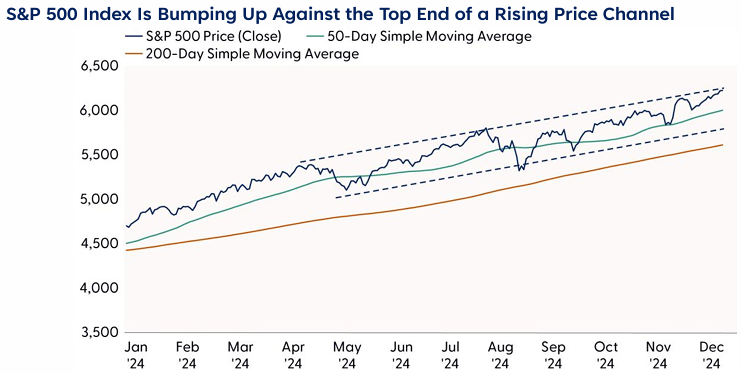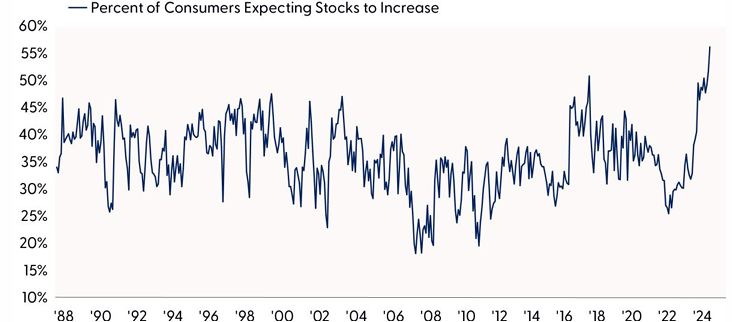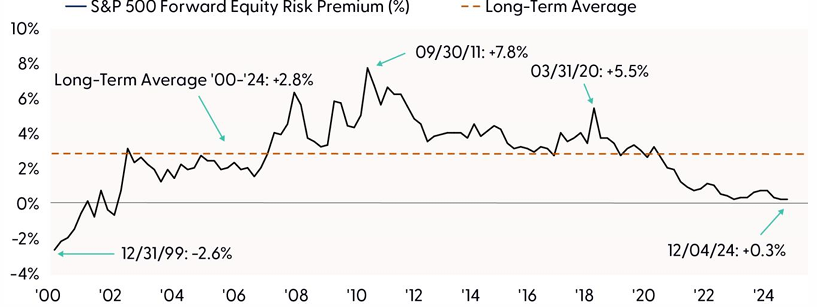LPL Research’s Outlook 2025: Pragmatic Optimism will be released tomorrow and available on LPL.com. Here we just provide an appetizer before the main course and share some of the stock and bond market themes covered in the full publication.
Macro Setup
Before getting to the markets, let’s set the stage with some of our expectations for the economic environment in 2025. We expect the following:
- Slowing growth, not recession. Consumer spending will likely moderate in 2025, while pent-up demand for capital investment could provide support.
- The labor market is slowly downshifting. Less job switching and fewer hours worked are indicative of less demand for workers. Watch for unemployment to inch higher next year, contributing to a modest economic slowdown.
- Inflation has moderated but remains historically elevated. Some segments of the population are under more pressure than others, making the job of monetary policymakers tricky in 2025.
- Price pressures may re-emerge in 2025, potentially slowing the pace of Federal Reserve rate cuts.
This environment should be favorable for equities as continued economic growth and moderating inflation support corporate profits and help yields from moving significantly higher. A re-acceleration in inflation is a key risk for the economy and markets. Tax and regulatory policy will be important factors.
What to Expect from Equity Markets in 2025
That macroeconomic environment should provide a good foundation for further stock market gains in 2025. Stocks have historically been up double-digits when the Fed starts cutting interest rates and recession is avoided.
Here are some highlights from our 2025 equity market forecasts:
- Bull markets that make it to year three, as this one has, and do not suffer a recession stand a very good chance at making it to year four.
- Strong earnings growth and stable interest rates are expected to help stocks maintain elevated valuations, although valuation expansion is unlikely.
- Keys to a possible valuation expansion, which could turn a decent 2025 into a very good one, are lower interest rates, productivity gains, and potential market-friendly policy changes from the incoming administration (more on valuation below).
- Key risks include a more pronounced economic slowdown, reaccelerating inflation, interest rate volatility, and geopolitical threats. A pullback is overdue and normal market behavior, particularly with valuations and investor sentiment stretched, as we discuss below, so favor buying equities on pullbacks.
- Annual gains are not likely to match 2024, but opportunities are likely to emerge below current levels in early 2024, potentially at the 50-day moving average (5,873). A test of the 200-day moving average (now at 5,481) is possible but would likely occur at a higher level as that moving average continues to rise.
S&P 500 Index Is Bumping Up Against the Top End of a Rising Price Channel

Source: LPL Research, Bloomberg, 12/04/24
Disclosures: All indexes are unmanaged and cannot be invested in directly. Past performance is no guarantee of future results.
Stretched Sentiment Suggests Near-Term Sell-Off
Our expectation for a near-term pullback is also supported by some measures of sentiment that suggest the amount of investor optimism has gotten stretched following such a strong rally in stocks this year. One particular investor survey illustrates this point. Each month, the Conference Board issues a consumer confidence survey, a sample from approximately 3,000 households across the United States. The survey asks respondents about their optimism (or pessimism) about the stock market, among other things. In the most recent November release, the percent of consumers who expected the stock market to increase hit an all-time high at over 56%. The survey goes back to the late-1980s, so this is meaningful.
One Survey of Investor Bullishness Has Reached an All-Time Record High

Source: LPL Research, Conference Board, Bloomberg, 12/03/24
Optimism after rallies is normal, but the level of optimism reflected in this survey has raised some eyebrows and may signal an increased risk of a near-term sell-off and contribute to LPL Research’s tempered enthusiasm for stocks as 2025 approaches. However, other surveys reveal complacency more than irrational exuberance, suggesting this is not a late-1990s type environment. At least not yet.
Rich Valuations Make It Tough to Forecast P/E Multiple Expansion
Related to sentiment, elevated valuations are another reason to expect more modest stock returns in 2025, though valuations are famously not good one-year timing tools (they are good at predicting returns five years out or more). The S&P 500 equity risk premium is not much above zero even if forward-12-month estimates for earnings per share are used (higher than earnings for the prior 12 months or a last-quarter annualized run rate). Simply put, the earnings that the stock market offers investors are not covering the yield offered by long-term Treasuries, and investors are not being well-compensated for the risk they are taking in equities.
Low Equity Risk Premium Indicates Elevated Stock Valuations Relative to Bonds

Source: LPL Research, FactSet, Refinitiv, 12/04/24
Disclosures: All indexes are unmanaged and cannot be invested in directly. Past performance is no guarantee of future results. S&P 500 equity risk premium is the S&P 500 earnings yield (earnings divided by price) minus the US 10-year Treasury yield. Earnings are forward 12 month estimates.
Valuations can stay high for extended periods of time, and we expect them to hold up in 2025, but looking beyond next year, if earnings growth slows it will be tougher for market participants to justify valuations.
What to Expect from Bond Markets in 2025
After a volatile 2024 for the bond market, we expect things to calm down in 2025. Here are some highlights from our 2025 bond market forecast:
- Expect yields to be range-bond. Deficit spending and Treasury supply may put upward pressure on longer-term yields, but Fed rate cuts could push yields in the other direction.
- Given a potential “higher for longer” environment next year, bond investors should continue to focus on income generation. Yields will likely remain attractive.
- Focus on intermediate maturities for fixed income exposure to limit sensitivity to interest rates and balance yield and risk.
Conclusion
There’s a 2025 Outlook appetizer before the main course arrives tomorrow. Call us pragmatic optimists after such a strong 2024 — we detect a path to a really good year for stocks in 2025, but several factors temper our enthusiasm, including stretched sentiment and the potential that inflation re-accelerates. Further, tariffs could challenge corporate profits, and enthusiasm for tax cuts in 2026 could be overdone. Bottom line, our base case forecast calls for slowing economic growth, modest stock market gains with some upside potential, and range-bound interest rates that enable investors to focus on income generation and benefit from the higher-for-longer environment.
For much more on our expectations for markets in 2025, including alternative investments, commodities, currencies, and more, please find our Outlook 2025: Pragmatic Optimism, available Tuesday, December 10.
Asset Allocation Insights
LPL’s Strategic and Tactical Asset Allocation Committee (STAAC) maintains its tactical neutral stance on equities, with a preference for the U.S., a slight tilt toward growth, and benchmark-like exposure across the market capitalization spectrum. However, we do not rule out the possibility of short-term weakness as sentiment remains stretched and a lot of good news is priced into markets even as geopolitical threats escalate. Equities may also need to readjust to what could be a slower and shallower Fed rate-cutting cycle than markets are currently pricing in, although December seasonality is favorable.
Important Disclosures
This material is for general information only and is not intended to provide specific advice or recommendations for any individual. There is no assurance that the views or strategies discussed are suitable for all investors or will yield positive outcomes. Investing involves risks including possible loss of principal. Any economic forecasts set forth may not develop as predicted and are subject to change.
References to markets, asset classes, and sectors are generally regarding the corresponding market index. Indexes are unmanaged statistical composites and cannot be invested into directly. Index performance is not indicative of the performance of any investment and do not reflect fees, expenses, or sales charges. All performance referenced is historical and is no guarantee of future results.
Any company names noted herein are for educational purposes only and not an indication of trading intent or a solicitation of their products or services. LPL Financial doesn’t provide research on individual equities.
All information is believed to be from reliable sources; however, LPL Financial makes no representation as to its completeness or accuracy.
All investing involves risk, including possible loss of principal.
US Treasuries may be considered “safe haven” investments but do carry some degree of risk including interest rate, credit, and market risk. Bonds are subject to market and interest rate risk if sold prior to maturity. Bond values will decline as interest rates rise and bonds are subject to availability and change in price.
The Standard & Poor’s 500 Index (S&P500) is a capitalization-weighted index of 500 stocks designed to measure performance of the broad domestic economy through changes in the aggregate market value of 500 stocks representing all major industries.
The PE ratio (price-to-earnings ratio) is a measure of the price paid for a share relative to the annual net income or profit earned by the firm per share. It is a financial ratio used for valuation: a higher PE ratio means that investors are paying more for each unit of net income, so the stock is more expensive compared to one with lower PE ratio.
Earnings per share (EPS) is the portion of a company’s profit allocated to each outstanding share of common stock. EPS serves as an indicator of a company’s profitability. Earnings per share is generally considered to be the single most important variable in determining a share’s price. It is also a major component used to calculate the price-to-earnings valuation ratio.
All index data from FactSet or Bloomberg.
This research material has been prepared by LPL Financial LLC.
Not Insured by FDIC/NCUA or Any Other Government Agency | Not Bank/Credit Union Guaranteed | Not Bank/Credit Union Deposits or Obligations | May Lose Value
For public use.
Member FINRA/SIPC.
RES-0002562-1124 Tracking # 668385/668386 (Exp. 12/25)